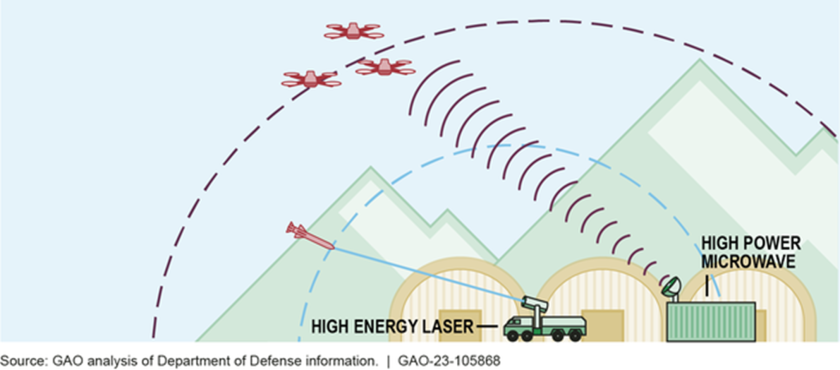The US Department of Defense (DOD) is currently developing directed energy weapons with the goal of defeating a range of threats, including drones and missiles but its efforts to transition prototypes to acquisition programs face challenges, according to an April report from the US Government Accountability Office (GAO).
“DOD spends USD1 billion annually on developing directed energy—concentrated electromagnetic energy—weapons. For example, DOD has developed high-energy lasers that have successfully shot down drones in demonstrations. However, DOD has had trouble getting these technologies out of the lab and into the field for several reasons—including determining how to use them in missions. The Army developed a detailed transition plan describing schedules and stakeholder roles to support moving these weapons into development. However, the Navy and Air Force haven’t done the same. We recommended they do so.”
The report goes on:
“However, DOD has long noted a gap—sometimes called “the valley of death”—between its development and its acquisition communities that impede technology transition. For example, the acquisition community may require a higher level of technology maturity than the development community is able to produce.
“For prototypes that a military department expects to eventually transition to a new or existing acquisition program, it needs to identify a transition partner that can support the further development of the new technology. To support transition, the Army developed a detailed plan describing schedules and stakeholder roles to build supporting activities around the use of directed energy weapons and early capabilities documents. However, while the Navy fielded several directed energy weapon prototypes and identified a potential transition partner, it does not have documented transition agreements for the directed energy programs that GAO reviewed. The Air Force has not consistently prioritized establishing transition partners, which makes planning for future transition even more challenging. Without these transition planning steps, the Navy and Air Force risk developing directed energy weapons that may be misaligned with operational needs.
The DoD current spends about USD1 billion annually on directed energy—concentrated electromagnetic energy—weapons, including high energy lasers and high power microwaves. GAO is making four recommendations to DOD, including that the Navy and the Air Force develop transition agreements between prototype developers and planned transition partners. DOD concurred with three recommendations and partially concurred with one recommendation. GAO continues to believe that the recommendation should be fully implemented.
Recommendations for Executive Action
| Agency Affected | Recommendation | Status |
| Department of the Navy | The Secretary of the Navy should ensure the Assistant Secretary of the Navy for Research, Development and Acquisition, for efforts the Navy expects to transition to an acquisition program, develop transition agreements between prototype developers and identified transition partners within the first year of a DE prototype project, or as soon as possible. (Recommendation 1) | Open
When we confirm what actions the agency has taken in response to this recommendation, we will provide updated information. |
| Department of the Air Force | The Secretary of the Air Force should ensure the Assistant Secretary of the Air Force for Acquisition, Technology, and Logistics, for efforts the Air Force expects to transition to an acquisition program, identify transition partners early and develop transition agreements between prototype developers and identified transition partners within the first year of a DE prototype project, or as soon as possible. (Recommendation 2) | Open
When we confirm what actions the agency has taken in response to this recommendation, we will provide updated information. |
| Department of the Navy | The Secretary of the Navy should ensure the Assistant Secretary of the Navy for Research, Development and Acquisition documents how the Navy collects, tracks, and incorporates DE prototype user feedback during development and testing. (Recommendation 3) | Open
When we confirm what actions the agency has taken in response to this recommendation, we will provide updated information. |
| Department of the Air Force | The Secretary of the Air Force should ensure the Assistant Secretary of the Air Force for Acquisition, Technology, and Logistics documents how the Air Force collects, tracks, and incorporates DE prototype user feedback during development and testing. (Recommendation 4) | Open
When we confirm what actions the agency has taken in response to this recommendation, we will provide updated information. |
For more information
https://www.gao.gov/products/gao-23-105868
(Image: Notional Depiction of High Power Microwave and High Energy Laser Defending an Installation)




